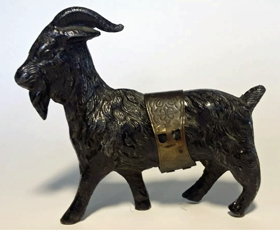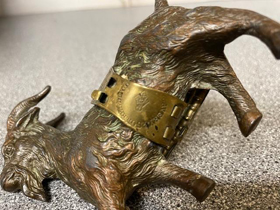Goat with Panniers

Needle Case (photographs courtesy of Bunny's Place)
Patent/design registration not found
There is some question about the authenticity of this item. However, since it meets all of the criteria we have established for classification as an Avery needle case, it will remain on our Master List unless additional evidence is uncovered. The example seen in most of the photos on this webpage may have been part of Ruth Mann’s Avery collection because it was sold by the antique dealer known as Bunny’s Place who was responsible for the sale of Ruth’s collection between 2005 and 2010. Recently two additional examples of this needle case have been found which can be seen in the photogrpahs below. One was for sale on eBay in 2025, however it was missing the basket parts of the panniers. Another was obtained that same year by Robert Bleasdale of Bleasdales Ltd Auctions in Warwick, UK, an auction house that specialized in sewing related antiques. The fact that three examples have been found makes it much more likely that it is in fact an authentic Avery needle case.
However, since a design registration/patent for this item has not been found and only three examples have been located, some skeptics believe it might be a later creation, two unrelated pieces brought together to form a new item. Let’s say in Victorian times the lady of the house had the Donkey with Panniers needle case on her dressing table while her son had a menagerie of cast metal animals, including a goat, with which he played; toys produced in Birmingham around the same time as the needle case. At the end of his mother’s life, the son inherits a box which contains both items along with other articles. Later when he opens the box to review its contents he discovers one of the donkey's legs is broken. At the same time he sees the goat and it brings back memories of his childhood when the family went on vacation and played with a goat that pulled a cart at the seaside resort they visited. The son decides the baskets might fit on the goat so he takes them and the metal goat to the local metal smith who creates the Goat with Panniers which of course is signed W. Avery & Son on the brass basket.
Generations later this item is discovered at an estate sale and voile, the antique dealer who discovers it is familiar with Avery needle cases, so she scarfs it up for a friend she knows who collects Averys. Since both pieces, the goat and the basket, were actually produced around the same time and the two pieces have been together for over 100 years, its authenticity is never questioned.
Now why do we think this story is plausible? The major question here is if the Goat with Panniers is an Avery style needle case, why was this design not registered? All other Avery style needle cases that combined a cast metal animal with another stamped brass piece were registered to W. Avery & Son or J. M. Farnol except the Dog Carrying Woven Basket which is also of questionable authenticity. We know Avery and Farnol worked together on at least two designs because Avery used Farnol's business address as his own when he registered them (see Elephant with Howdah and Lighthouse with Boat). The only company name ever found on these combination items is W. Avery & Son. The diamond registration mark on the piece attaching the baskets seems to be; 31, D, ?? which translates to ??/31/1878. A search for the design registration/patent for a needle case registered on the 31st of all months in 1878 was undertake and nothing was found.
Design Details
Needle Case Type: |
Figural |
Patent/Registered to: |
Unknown |
Patent/Design Representation #: |
Unknown |
Patent/Design Registration Date: |
Unknown |
Location of Patent/Design Registration: |
Unknown |
Reference #: |
Unknown |
Dimensions: |
Unknown |
Material: |
Brass |
Name Variations: |
W. Avery & Son - Redditch |
Other Variations: |
None |
Additional Photographs


Back and top views (photographs courtesy of Bunny's Place)


Left: Bottom signature detail (photograph courtesy of Bunny's Place. Right: photograph from eBay in 2025.


Photographs courtesty of Robert Bleasdale of Bleasdales Ltd, Warwick, UK.







